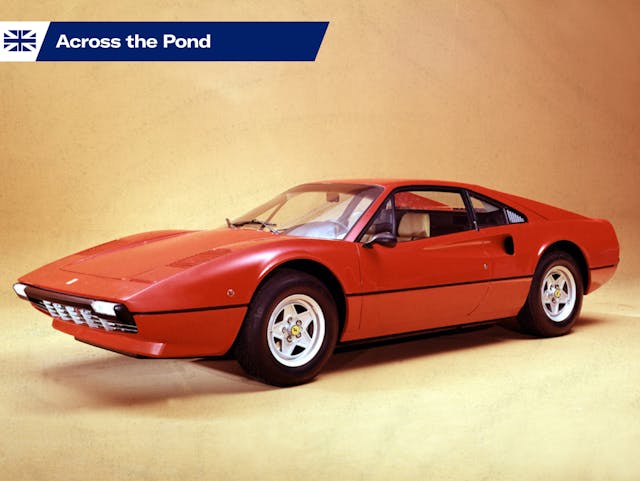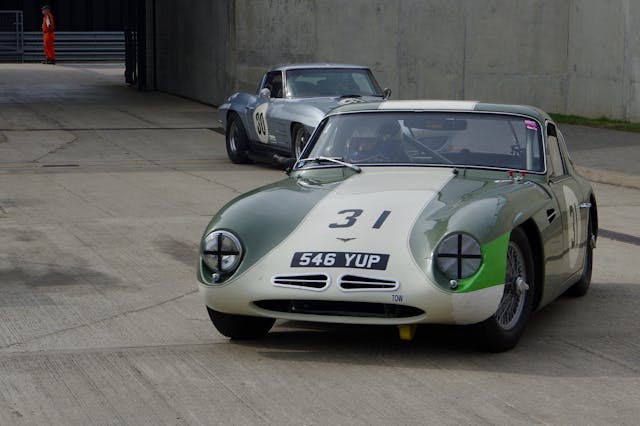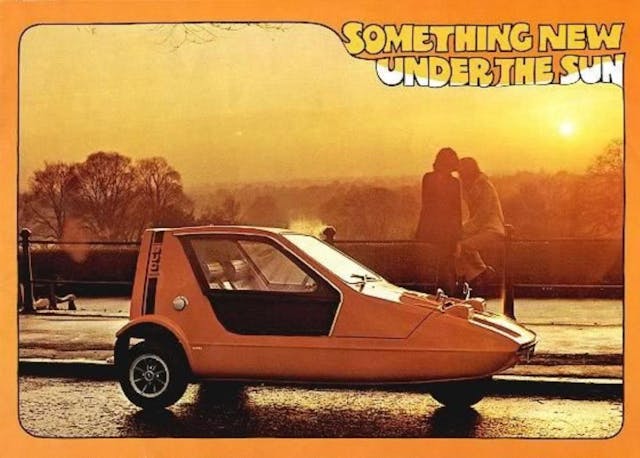Media | Articles
8 fiberglass cars that made plastic fantastic

The Corvette may be the most popular fiberglass-bodied car by volume, but it wasn’t the first—and it certainly isn’t the most exotic. Have a read of this list, compiled by our U.K. colleagues, and reinforce your belief in the fantastic possibilities of plastic. —Ed.
Though the British motor industry has been doing fantastic things with plastic for around seven decades, the history of fiberglass body construction goes back even further. In his excellent book Excess All Areas: British Kit Cars of the 1970s, Richard Heseltine charts the use of fiberglass in the United States, kickstarted in 1936 by the Owens-Illinois glass company and its pioneering use of continuous fibers of glass, using the trade name Fiberglas.

Five years later, Henry Ford unveiled the Soybean Car (above), which utilized 14 plastic panels attached to a steel tubular frame. According to The Henry Ford Museum of American Innovation, the body’s ingredients included soybeans, wheat, hemp, flax and ramie.
Today, the use of fiberglass is synonymous with the British specialist and sports car industries, but it’s a truly global affair.
1953 Chevrolet Corvette

The American Bill Tritt had been building fiberglass boats for two years when he was approached by friend Major Ken Brooks. Tritt was tasked with creating a European-style roadster based on the chassis of an old Willys Jeep, in which Brooks’ wife refused to travel. The result was the Brooks Boxer, which became the Glasspar G2, a car credited as being the world’s first fiberglass sports car.
Marketplace
Buy and sell classics with confidence
Tritt went on to design and build fiberglass cars for a range of companies, but his role in the creation of the Chevrolet Corvette is often overlooked. The G2 was presented to Harley Earl, General Motors’ vice-president in charge of styling. For Earl, it was a source of inspiration; the use of Glass-Fiber-Reinforced Plastic (GRP) would save money on tooling while underlining the Corvette’s position as the American sports car of the future.
GM’s promotional material extolled the virtues of the Corvette’s “two-passenger, open-cockpit body of glass-fiber reinforced plastic; light, strong, durable, rustproof, quiet and easy to repair.” For New Yorkers at the 1953 Motorama, plastic truly looked fantastic. And so began seventy years of series production.
1958 Jensen 541

On the other side of the Atlantic, Jensen was readying the world’s first four-seater car—and Europe’s first series production performance car—with a fiberglass body. The combination of a 4.0-liter straight-six engine and lightweight, aerodynamic body made it one of Britain’s fastest cars of the 1950s.
Jensen remained faithful to fiberglass construction with the 541R (pictured), 541S, and C-V8, before the arrival of the Interceptor in 1966 saw a return to a steel body shell.
1961 Lotus Elite

The Lotus Elite was one of the most revolutionary and significant cars of the 1950s. Unlike the Corvette, whose fiberglass panels were mounted on a separate chassis, the Elite featured a monocoque built entirely of fiberglass. This was the first time fiberglass had been used for the whole load-bearing structure of the car. The result was a car that weighed about the same as a bag of sugar, with a drag coefficient of just 0.29—in 1957!
The first 250 bodies were built by Maximar Mouldings of West Sussex, before quality issues saw the work being handed to the Bristol Aeroplane Plastics Limited. In an advertisement, Bristol called it “the most advanced car body ever built.” The copywriter probably had a point.
1958 TVR Grantura

A list of fiberglass cars wouldn’t be complete without a TVR, so it makes sense to feature the marque’s first production vehicle. The Grantura of 1958 featured a fiberglass body molded to TVR’s own tubular steel chassis, with the trailing arms and torsion bars from a Volkswagen Beetle.
Other components shipped in included the windscreen from a Ford Consul and the drum brakes from an Austin-Healey 100, along with a choice of engines sourced from Coventry Climax, Ford, and BMC.
1959 Daimler SP250

In some ways, the Daimler SP250 was the British Corvette. Launched as the Dart at the 1959 New York motor show, Daimler was forced to change the name to SP250 following a trademark complaint from Dodge.
Slow sales meant that the V-8-engined SP250 was the last hurrah for Daimler; the company was bought by Jaguar in 1960, before the axe fell on the sports car in 1964.
1970 Bond Bug

In an interview published in Classic.Retro.Modern. magazine, design genius Tom Karen named the Bond Bug and Marble Run as the two products of which he is most proud. With its orange paintwork, wedge shape, and black decals, the Bug is one of the most 1970s cars of the 1970s. In other news: It’s too long since we played Marble Run.
The brochure delivered a gloriously informal assessment of the benefits of a fiberglass body: “Rap the side of the Bug with your knuckle. There is no hollow, tinny sound; it gives a deep, solid thunk-thunk-thunk. The body of the Bug is made not of metal but of tough, reinforced glass fibre. There is a big advantage to you; because glass fibre cannot rust.”
Makes you thunk, doesn’t it?
1975 Ferrari 308 GTB

Many car names sound better in Italian: Quattroporte (four doors), Topolino (little mouse), Scuderia (stable), and Testarossa (redhead). So, it’s no surprise that the Ferrari 308 GTB “Vetroresina” sounds more exotic than the 308 GTB “Fiberglass.”
This was the first production Ferrari to feature a fiberglass body, but why did Maranello shift from steel? Probably because Ferrari needed to fast-track the development of a new car in response to the slow-selling 308 GT4. The subject of weight also played a part, while some historians speculate that Ferrari used fiberglass in case the car didn’t sell.
By late 1976, just a year after the 308 GTB made its debut at the Paris motor show, cars were arriving in the U.S. wearing steel bodies, although fiberglass cars remained on sale in Europe until the middle of 1977. Various reasons have been tabled for the switch from plastic to steel, including difficulty in finding specialists to repair accident damage, construction that was more labor-intensive than envisioned, and even the fact that fiberglass was never anything other than a temporary measure.
1977 Matra Rancho

Forget all the nonsense about the Nissan Qashqai being the first crossover. Plenty of other manufacturers had previously attempted to blaze the trail, most notably the Matra Rancho of 1977.
Built to satisfy the needs of would-be Range Rover owners who wanted to talk the talk, but didn’t necessarily need to walk the walk, it pioneered the concept of a rough and ready SUV without the ability to venture further off-road than a dropped curb on the Kings Road.
The fiberglass rear section was mounted on a steel frame, the rusting of which doomed too many examples of the radical oddball. Matra stayed true to fiberglass construction with the development of the Renault Espace.
The others

There are countless other fiberglass cars we could have included. The Lancia Stratos, Citroën Bijou, Gilbern Invader, AC 3000ME, Clan Crusader, Vauxhall VX220, and Reliant Scimitar, to name just a few.
A separate list could feature more plastic creations from TVR and Lotus, not to mention the myriad kit cars produced during the boom in self-build vehicles. But before we further extol the virtues of the body material, read how difficult it can be to properly restore a fiberglass body.
Check out the Hagerty Media homepage so you don’t miss a single story, or better yet, bookmark it.







The Fiero and all C4-C8 Corvettes are not fibreglass. They are SMC (sheet molded compound) which is a heat molded plastic sheet, not fibreglass. All saturns and the GM plastic vans were made of the same material
SMC is just a molded Fiberglass.
It was cheaper and easier to make in a higher quality.
No one today does the old style glass
The Fiero has fiber glass hood, top, and deck lid, all the rest is fiber reinforces flexible plastic. Satern also had RIM plastic in the first models. Pontiac Transport vans, Chevrolet Lumina, and the Oldsmobile Silhouette were all fiber glass panels. One of G.M. first fiber glass cars was a prototype 1952 Chevrolet.
Gavin! Please! How could you? AVANTI!!!! The most beautiful and at one time the fastest American production car. Not a straight line in that that fiberglass body! I have owned my 63 Avanti for almost 51 years, so maybe I am a bit one sided.
But U R right, Rick!
Actually, it was the WORLD’s fastest car for 1963!
There was also the Woodill Wildfire built in Downey California. It was sold as both a complete sport car and as a kit. It was built from 1952 to 1958, before the Corvette.
Wasn’t the saab sonnett fiberglass? Bricklin too?
No Saab story, the Sonett
Trabant wasn’t technically fiberglass, but it was a composite.
There are a lot of plastic cars left out (and the link to all the supposed kit cars goes instead to an article about one Cisitalia). Naturally I object to the omission of Ginetta, because I own one.
Coming of driving age in the mid-west and watching my first love dissolve with rust [’66 Mercury Montclair, Palisades Turquoise], owning something that wouldn’t do that was a dream.
Maybe one of those LaDawri kit cars!!!!
I learned bondo skills on that car. Dad kept a stiff upper lip about it at least, bless him.
Cars like the Checker and Studebaker Lark with their fenders on all four corners being removable for repair or replacement were the ideal for me if fiberglass wasn’t an option.
That Mercury was going to be my “forever” car [at 16] and to see it brought low by salt…
Maybe that’s why I loved Saturns: polymer, removable panels, space frame, simplicity.
Not exotic. Fiero construction principles were used on not only the original S Series, but the Dustbuster vans.
Any alternative to rusting metal bodies always fascinated me.
I keep my cars. They all become “Forever” cars.
Loved this article.
Check out the article in the October/22 of Vette Vue’s magazine 1945/46 Stout fiberglass car one of the I think Bill Tritt have something to do with it not sure but a very good article check it out I was impressed with the article on early fiberglass cars
A bit different but you didn’t mention that DeLorean bodies are fiberglass. The underbody is fiberglass sheeted over with a layer of stainless steel panels.
Why are not the Studebaker Avanti and the Avanti included?
Whaaaaat? No mention of the Avanti? Come on, Gavin…you can do better than this…
The Saab Sonett was also made of fiberglass
A lot of fiberglass cars were left out.
Like many have said, how did you forget the AVANTI???
So what about Studebaker Avanti? Poor Studebaker never gets any respect!